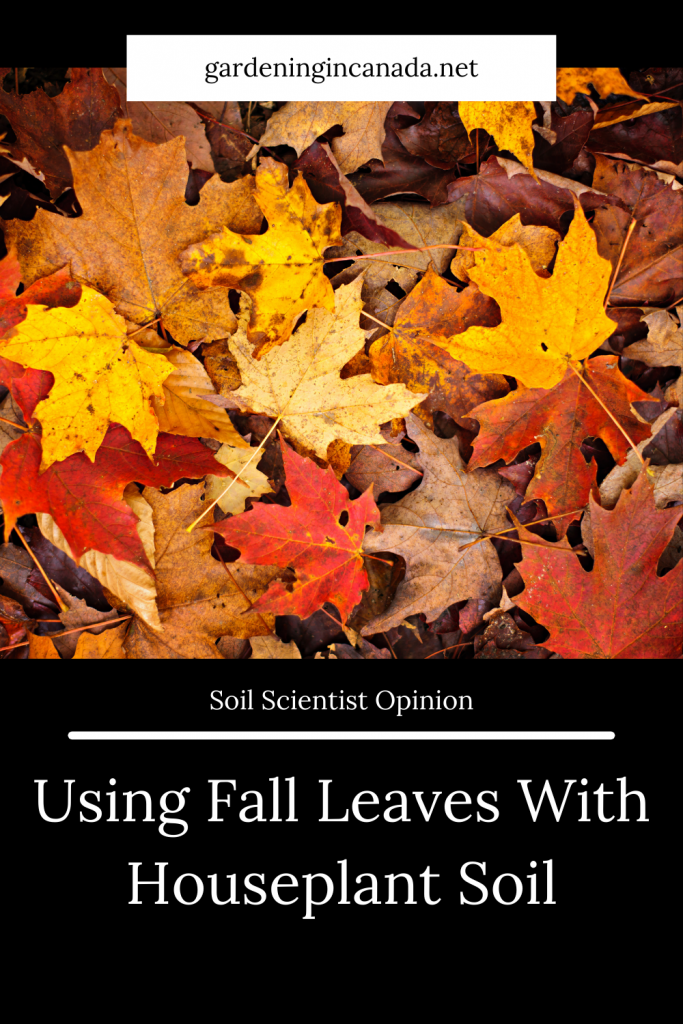- Canada’s Growing Zones Are Changing 2024 - January 12, 2024
- Attracting Wildlife To The Garden - May 16, 2023
- How To Garden Near A Septic Tank - May 9, 2023

How To Use Old Tree Leaves With Your Houseplants
Old tree leaves are a staple of fall but it seems wasteful to simply throw them into the garbage. However, applying these to your garden or houseplants the wrong way can be equally as damaging to your soil nutrients. This gardening in Canada article looks at how to use old tree leaves with houseplants properly.
If you are new to this blog my name is Ashley and I am a soil scientist. I am located in a Canadian Zone 3 and a USDA Zone 4. I write articles, make YouTube videos, Instagram posts all designed for Canadians and Cold Climate gardeners using science-based methods. If you are looking for anything specific be sure to let me know in the comments down below.
Why Are Leaves Valuable For Houseplants?
Leaves provide two things to garden soil. The first is different forms of nutrients and the second is a diverse group of microbes. Most forms of organic material are decomposed using bacteria. With leaves, the main decomposer is actually fungi. This means when decomposed leaves are added to a garden we increase the biodiversity of the soil.
The nutrients contained within leaves are similar to most organic materials. One thing that differs is the C:N (Carbon:Nitrogen) ratio. Leaves have a high carbon to nitrogen ratio, this is why bacteria do not do well in this environment and fungi are the key decomposer. High carbon is never a bad thing when it comes to soil additives. Carbon is arguably a nutrient in much higher demand than nitrogen.
Carbon also plays a vital role in soil structure. If you are wanting to increase aggregation and the soil’s water-holding capacity the addition of leaves is key. The carbon within soil acts as a glue to help hold the soil together. This helps with water conservation & reducing topsoil losses.
When using old tree leaves with houseplants however you will want to look at making leaf mould. We will talk about how to make leaf mould a bit later. The leaf mould will provide very much need microbes for the houseplants and even nutrients without causing any fertilizer burn or stress. Leaf mould with houseplants can even be used as soil all on its own!
Why Do Leaves Steal Nitrogen From The Soil
Yes, leaves can steal nitrogen from the soil and surrounding areas. We spoke about this in the mulching videos but let’s review. When it comes to decomposition bacteria need to use nitrogen. This means that nitrogen from surrounding areas such as the soil is taken from the system to be used in the process of decomposition.
When we top-dress or mulch we are not worried about this uptake because it acts as a weed suppressor and does not affect the plant roots. However, when we incorporate organic material into the soil we then run the potential of affecting the plants. This is why when you choose to use leaves in the garden the best choice is top dressing. This means your leaves serve as a way of retaining moisture rather than nutrients. If you are wanting to use the leaves as a form of fertilizer or soil amendment then I suggest making your own leaf mould.
When it comes to old tree leaves with houseplants you want to make sure they are not incorpated into the soil or top dressed. Topdressing houseplants with old tree leaves will cause too much water retention which would cause root rot. If we incorporate non decomposed leaves into the potting soil we may have nitrogen losses and ultimately signs of deficiencies.
How To Make Leaf Mould For Houseplants
- Step One. Chop up the leaves into smaller bits using a lawnmower. This will help speed up the process of decomposition. It’s not 110% necessary but you will notice a faster turnaround.
- Step Two. Place the leaves inside either a plastic bag or simply piling them up in a designated area of the yard.
- Step Three. Wait 6 months to one year. Adding moisture when things look a bit dry.
The finished product will look like compost. This can be used to start seedlings, mixed into potting soil, top dresser or incorporated into the soil. Both gardens and indoor planting systems will find the leaves beneficial.
Old tree leaves are a staple of fall but it seems wasteful to simply throw them into the garbage. However, applying these to your garden the wrong way can be equally as damaging to your soil nutrients. This gardening in Canada article looks at how to use old tree leaves in your garden properly. Let me know in the comments below if you use leaves with your plants.
